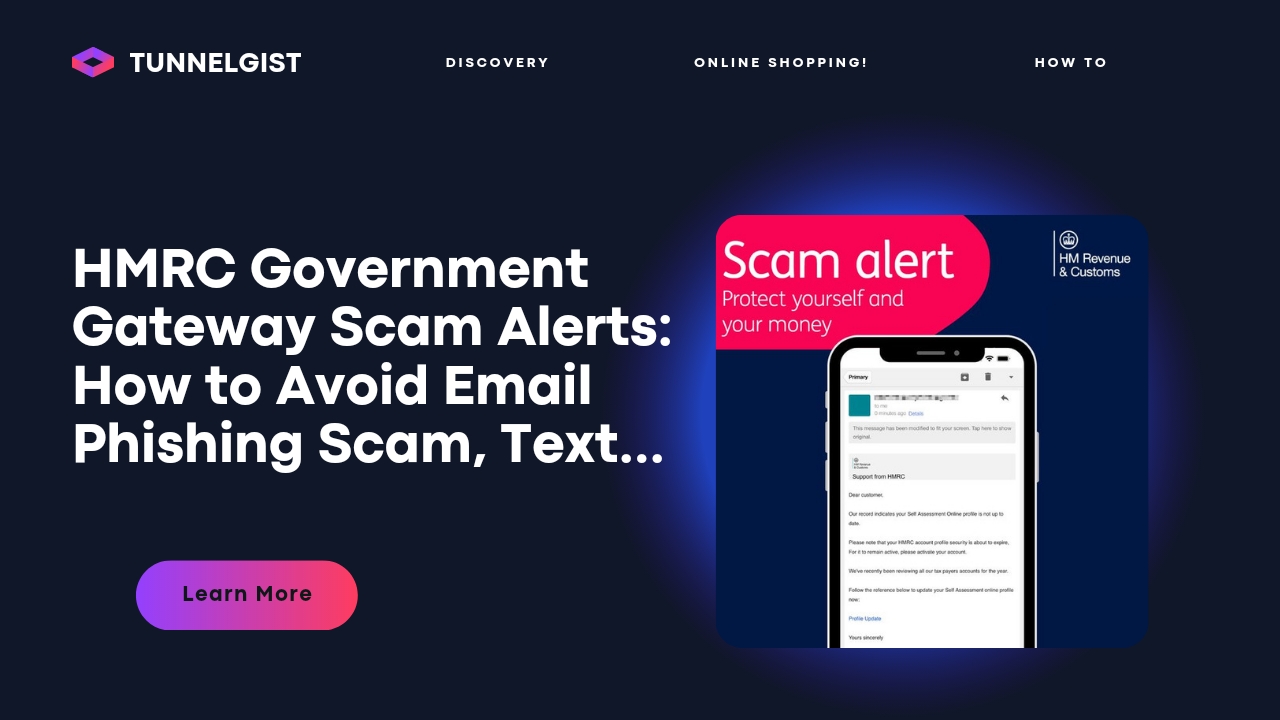
HMRC Government Gateway Scam Alerts: How to Create a Government Gateway Account & Avoid Email Phishing! (2024)
Avoiding Email Phishing in today’s digital age, scams and frauds have become an all too familiar threat to individuals and businesses alike. One such scam that has caught the attention of many is the HMRC Government Gateway scam. This fraudulent activity involves individuals receiving fake emails or text messages claiming to be from Her Majesty’s Revenue and Customs (HMRC), requesting personal information or payments.
In this blog post, we will explore the dangers of the HMRC Government Gateway scam and guide you on how to protect yourself from falling into its trap. We will also discuss how to create a government gateway account securely and avoid email phishing scams.
Read More:
Disclaimer/Note: This document is for informational purposes only and does not constitute financial or legal advice. It is based on the available information as of 2024, and individual experiences may vary.
Table of Contents
Understanding the HMRC Government Gateway Scam
The HMRC Government Gateway scam typically involves individuals receiving an email or text message claiming to be from HMRC. The sender may claim that there is a problem with their tax payment or that they need to update their details through the Government Gateway portal. The email or text message may also contain links or attachments that supposedly direct the user to a Government Gateway login page.
However, these emails and text messages are fraudulent and should be disregarded. The HMRC will never contact individuals directly via these methods to request personal information or payments. Instead, they send letters and official invoices through the post.
How to Create a Government Gateway Account Safely
If you are required to create a Government Gateway account, it is crucial to do so securely and with caution. Follow these steps to create a government gateway account safely:

1. Verify the Authenticity of Emails: Before clicking on any links or attachments in an email, verify the authenticity by cross-checking the sender’s email address. Look for official HMRC email addresses, such as [email protected].
2. Use the Correct Website: When accessing the UK Government Gateway portal, ensure that you use the official government website. Avoid clicking on any links or advertisements that may appear elsewhere.
3. Be Aware of Suspicious Behavior: If you encounter any suspicious behavior, such as grammatical errors or inconsistencies in the content, it is a red flag that indicates a potential scam. Trust your instincts and avoid engaging with the sender.
4. Use Strong Passwords: When creating your Government Gateway account, use a strong and unique password. Avoid reusing passwords across multiple accounts, as this increases your vulnerability to hacking attacks.
5. Avoid Phishing Emails: If you receive any unsolicited emails or text messages claiming to be from HMRC, do not respond to them or click on any links provided. Report these emails to HMRC’s phishing reporting service by forwarding them to [email protected].
How Do I Avoid Email Phishing Scams related to HMRC scam email, call or text?
Introduction:
The HMRC (Her Majesty’s Revenue and Customs) is alerting the public about a new scam email that targets government gateway login details and has also posted details on Twitter/other social media accounts too. These fraudulent emails are deceiving individuals into providing their sensitive information, leading to potential identity theft and financial fraud. This document outlines several measures that individuals can take to protect themselves from such scams.
1. Be Skeptical of Unexpected Communications
Phishing scams often rely on a sense of urgency or fear to trick individuals into responding. If you receive any communication claiming to be from HMRC, whether it is an email, call, or text, always take a moment to verify the authenticity. Genuine HMRC communications are typically sent from official HMRC email addresses or phone numbers. It is important to avoid clicking on any links or responding to any requests until you have confirmed that the message is legitimate.
2. Look for the Signs of a Phishing Email
Phishing emails often contain telltale signs that should not be overlooked. These include:
• Poor grammar and spelling errors
• A sense of urgency or threatening language
• Requesting sensitive information, such as passwords, bank details, or government gateway credentials
• Using generic greetings, such as “Dear Customer,” rather than addressing the recipient by name
• Including generic attachments, such as PDF or Word documents, that may contain malicious code
3. Be Aware of Vishing and Spoofing
In addition to email phishing, individuals should also be cautious of vishing (voice phishing) and spoofing. Vishing involves scammers posing as HMRC officials over the phone and demanding payment or personal information. Similarly, spoofing involves using fake caller ID information to make it appear as if a legitimate HMRC phone number is calling. If you receive an unexpected call or text related to HMRC, do not disclose any personal information and hang up.
4. Use Official HMRC Websites and Services
To avoid falling victim to phishing scams, it is crucial to use official HMRC websites and services. The websites of HMRC are secure and have measures in place to protect your personal information. Additionally, HMRC provides a range of official channels for communication, such as their helpline and online services. Identify text/email phishing scam, check for yourself and guidance Official Government link!
5. Safeguard Your Credentials
It is crucial to protect your government gateway login details, as they are crucial to accessing government services. Avoid sharing your password or any other sensitive information with anyone, even if they are claiming to be from HMRC. Enable two-factor authentication whenever possible to further secure your account.
By following these precautions, individuals can protect themselves against potential fraud and maintain the security of their personal information.
You may also like 👇
Conclusion:
The HMRC Government Gateway scam is an unfortunate reality in today’s digital world. However, by staying vigilant and following best practices, you can protect yourself from falling into its trap. Take the time to verify the authenticity of emails, use the correct website, and be aware of suspicious behavior. Additionally, create a secure Government Gateway account by using strong passwords and being cautious of phishing attempts. By staying informed and cautious, you can safeguard your sensitive information and avoid falling victim to these fraudulent activities.



